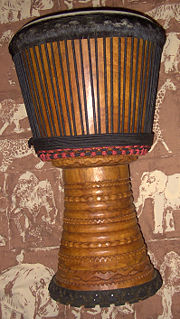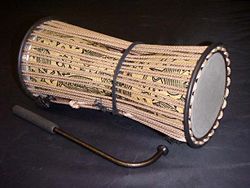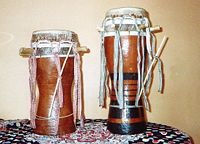 Djembe
Djembe
Play Clip
(pronounced / JEM-bay) also known as djimbe, jenbe, jembe, yembe, or sanbanyi in Susu; is a skin covered hand drum, shaped like a large goblet, and meant to be played with bare hands. According to the Bamana people in Mali, the name of the djembe comes directly from the saying "Anke dje, anke be" which literally translates to "everyone gather together", and defines the drum's purpose. "Dje" is the verb for "gather" in Bamanakan, and "be" translates as "everyone" in Bamanakan
 Talking drums
Talking drums
Play Clip
The talking drum is a West African drum whose pitch can be regulated to the extent that it is said the drum "talks". The player puts the drum under one shoulder and beats the instrument with a stick. A talking drum player raises or lowers the pitch by squeezing or releasing the drum's strings with the upper arm. This can produce highly informative sounds to convey complicated messages.
Talking Drums are hour-glass shaped with two heads (made from either goat, lizard (iguana), or fish skin) tuned by straps that connect the heads with each other. They are some of the oldest instruments used by west Africans and their history can be traced back to ancient Ghana Empire.
In the 20th century the talking drum became a part of popular music in West Africa. It is used in playing Mbalax music of Senegal and Jùjú music of Nigeria.
 Sabar
Sabar
Play Clip
The sabar is traditional drum from the West African nation of Senegal. It is generally played with one hand and one stick. Among its most renowned exponents is the Senegalese musician Doudou N'Diaye Rose . The sabar was used to communicate to other villages. The different rhythms correspond to phrases and could be heard for over 15 kilometers.
Sabar is also recognized as the style of music played while using this drum